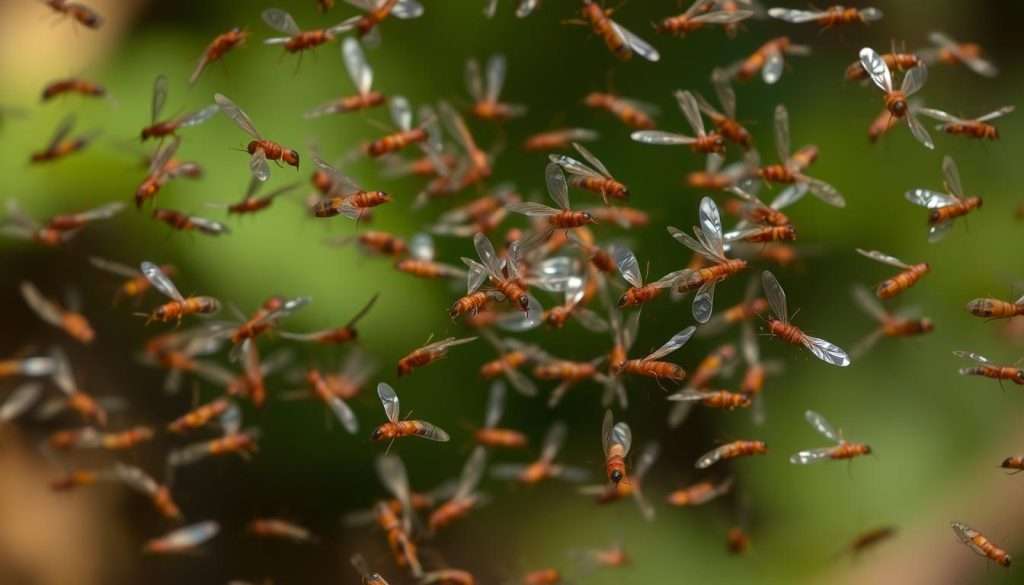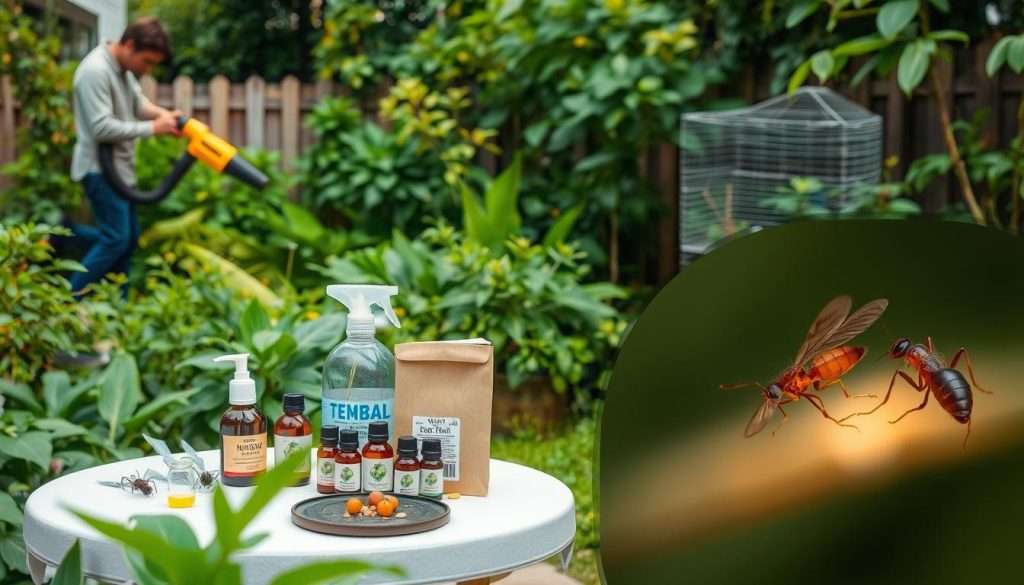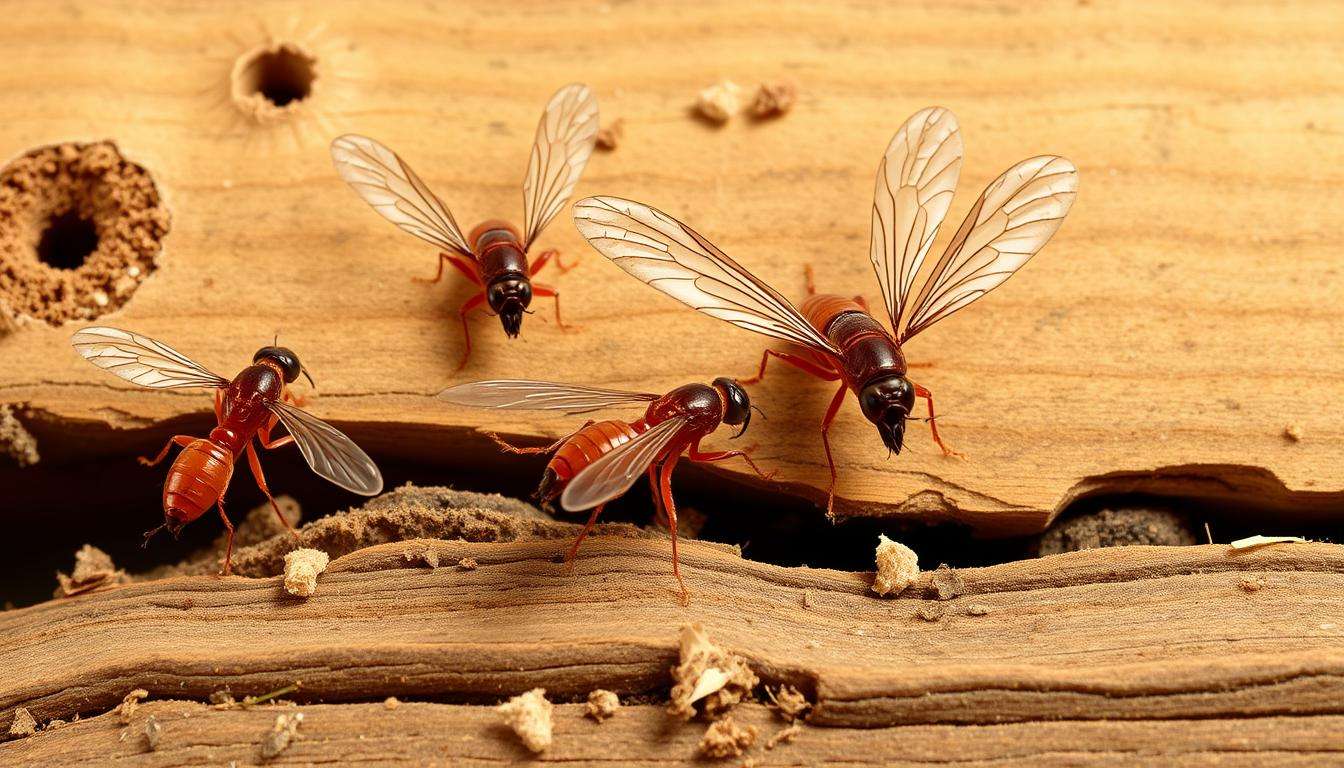Flying termites, or termite swarmers, can be a big problem for homeowners. The Environmental Protection Agency says termite damage costs billions each year. It’s important to know about these pests before they damage your home.
Flying termites don’t eat wood. They are the reproductive part of a colony looking to start new nests. We’ll show you how to get rid of flying termites, how to spot them, and expert solutions to keep your home safe.
Key Takeaways
- Flying termites, or swarmers, are the reproductive members of a mature termite colony.
- Infestations can quickly lead to significant damage if not addressed promptly.
- Identifying early signs of flying termites is crucial for effective treatment.
- Implementing preventive strategies can help avoid future infestations.
- Professional extermination is often the safest and most effective approach.
What Are Flying Termites?
Flying termites, also called termite swarmers, are the reproductive termites in a colony. Knowing their habits and traits helps spot them and stop infestations. They swarm in warm, humid weather in spring. This happens when the colony is mature, usually two to four years after it starts.
Understanding Termite Swarmers
Termite swarmers are crucial in a termite colony’s life cycle. They fly to mate and start new colonies when the time is right. Environmental factors like rain and humidity make them swarm in large numbers. But, only a few will find mates and start new colonies.
Characteristics of Flying Termites
Flying termites have unique features that make them different from other insects:
- Size and Shape: They look like flying ants but have equal-length wings.
- Color: In Texas, they can be red, dark, or pale tan, depending on the species.
- Life Span: If they find mates and start colonies, they can live over five years.
- Behavior: After flying for about an hour, most will lose their wings and die when they land.

| Feature | Flying Termites | Flying Ants |
|---|---|---|
| Wings | Equal length | Two larger upper wings |
| Color Variations | Red, dark, pale tan | Varies, typically darker tones |
| Life Span | Over 5 years if successful | Typically shorter, varies by species |
| Swarming Behavior | Mature colonies swarm in millions | Less frequent, typically smaller groups |
Knowing how to spot flying termites is key for homeowners. Understanding their life cycle and behavior helps prevent and manage infestations.
How to Identify Flying Termites
Spotting flying termites early can protect your home. Knowing the signs of infestation is key. Look for certain signs and features to identify termite swarms.
Signs of Infestation
- Swarm Presence: Seeing swarming insects near lights in spring and early summer is a sign. Look for discarded wings on windowsills too.
- Mud Tubes: Find mud tubes on walls or foundations. They help termites move and stay moist.
- Damage Indicators: Check wood for soft or hollow spots. This shows termites have been eating the wood.
Distinguishing Features
Knowing the difference between termites and ants is important. They look similar but have key differences:
| Feature | Termites | Ants |
|---|---|---|
| Body Structure | Straight body without a noticeable waist | Pinched waist and segmental body parts |
| Wings | Equal-sized wings that are longer than the body | Unequal-sized wings with hind wings shorter than forewings |
| Color | Usually light brown to cream | Varies, often darker (black or reddish-brown) |
| Behavior | Swarm during specific seasons, not aggressive | Aggressive when disturbed, sometimes swarm in various conditions |
How to Get Rid of Flying Termites
Act fast to protect your home from flying termites. Quick actions can cut down their numbers. Effective methods can get rid of them for good. Here’s how to handle it well.
Immediate Actions to Take
Act quickly when you see flying termites. Seal cracks in windows and doors. Keep wood away from soil to avoid attracting them. Reducing moisture is key since termites love damp places. Here are some quick steps:
- Fix leaks and drainage to deny termites water.
- Keep plants 6 to 12 inches from your home.
- Store firewood 15 feet away from your home.
- Turn off outdoor lights during swarming season to avoid attracting termites.
Effective Extermination Methods
Knowing how to get rid of termites is important. For DIY, you can make your own solutions. For example:
- A soapy mixture with orange or neem oil to stop their life cycle.
- Boric acid and diatomaceous earth to dehydrate and kill them.
DIY can help, but call a pro for big problems. Experts use:
- Foam or liquid insecticides like Taurus SC and Termidor SC.
- Termite baits around the foundation for long-term control.
- Beneficial nematodes to kill whole colonies.
Use monitoring stations to catch termites early. Call a pest service if you see a lot of activity.

| Method | Effectiveness | Notes |
|---|---|---|
| DIY Solutions (Orange Oil) | Moderate | Good for small problems |
| Boric Acid | High | Works on many insects, including termites |
| Foam Insecticides | Very High | Targets termites inside |
| Professional Pest Control | Very High | Best for big infestations |
Preventing Future Infestations
It’s key to stop flying termites from getting into your home. This helps keep your home safe from damage. By using the right termite prevention and long-term solutions, you can lower the risk of termite problems.
Termite Prevention Strategies
Here are some ways to stop termites:
- Fix any water leaks in your home. Termites love moisture, so it’s important to fix leaks and ensure good drainage.
- Keep mulch, wood, and plants 12 inches away from your home. This helps keep termites from getting close.
- Check and fix any damaged wood often. Fixing wood quickly can stop termites from getting in.
Long-term Solutions
For lasting protection, try these:
- Put termite bait stations around your home. These attract and kill termites before they damage your home.
- Get regular termite checks as part of your home care. This catches termites early, so you can act fast.
- Use natural insecticides like boric acid and white vinegar. They are good homemade sprays against termites.
Using these termite prevention tips can help you avoid flying termites. For more help and advice, check out this resource.
Conclusion
Knowing how to get rid of flying termites is key to keeping your home safe. These pests can cause big problems if not stopped fast. Look out for signs like discolored walls or squeaky floors to act quickly.
Termite swarms mean there are many colonies, which is a big issue. Using the right extermination methods and tips can help protect your home. Also, keeping your home dry and getting regular checks are important to stop damage.
Getting help from pest control experts is a smart move. They can offer solutions like termite bonds for extra protection. Acting fast is crucial to avoid expensive repairs.
With the right steps, you can fight flying termites and keep your home safe and healthy. Knowing what to do and who to call can make a big difference.
